Analyzing Cultural Diversity: Management Strategies in Three Nations
VerifiedAdded on 2023/06/04
|9
|2213
|447
Essay
AI Summary
This essay provides a comparative analysis of cultural diversity and its impact on management practices in Vietnam, Sudan, and India. It examines the unique cultural backgrounds of each country, including traditions, religions, and social structures, and discusses how these factors influence workplace dynamics and management strategies. The essay highlights the importance of cultural competence and sensitivity in addressing potential misunderstandings and conflicts arising from cultural differences. It also suggests approaches to promote inclusivity and effective communication within diverse teams, emphasizing the need for cross-cultural training and fostering a culture of mutual respect and understanding. The analysis covers specific challenges and opportunities associated with managing cultural diversity in each national context, providing valuable insights for business leaders and managers operating in these regions. Desklib provides this essay as a resource for students studying cross-cultural management.
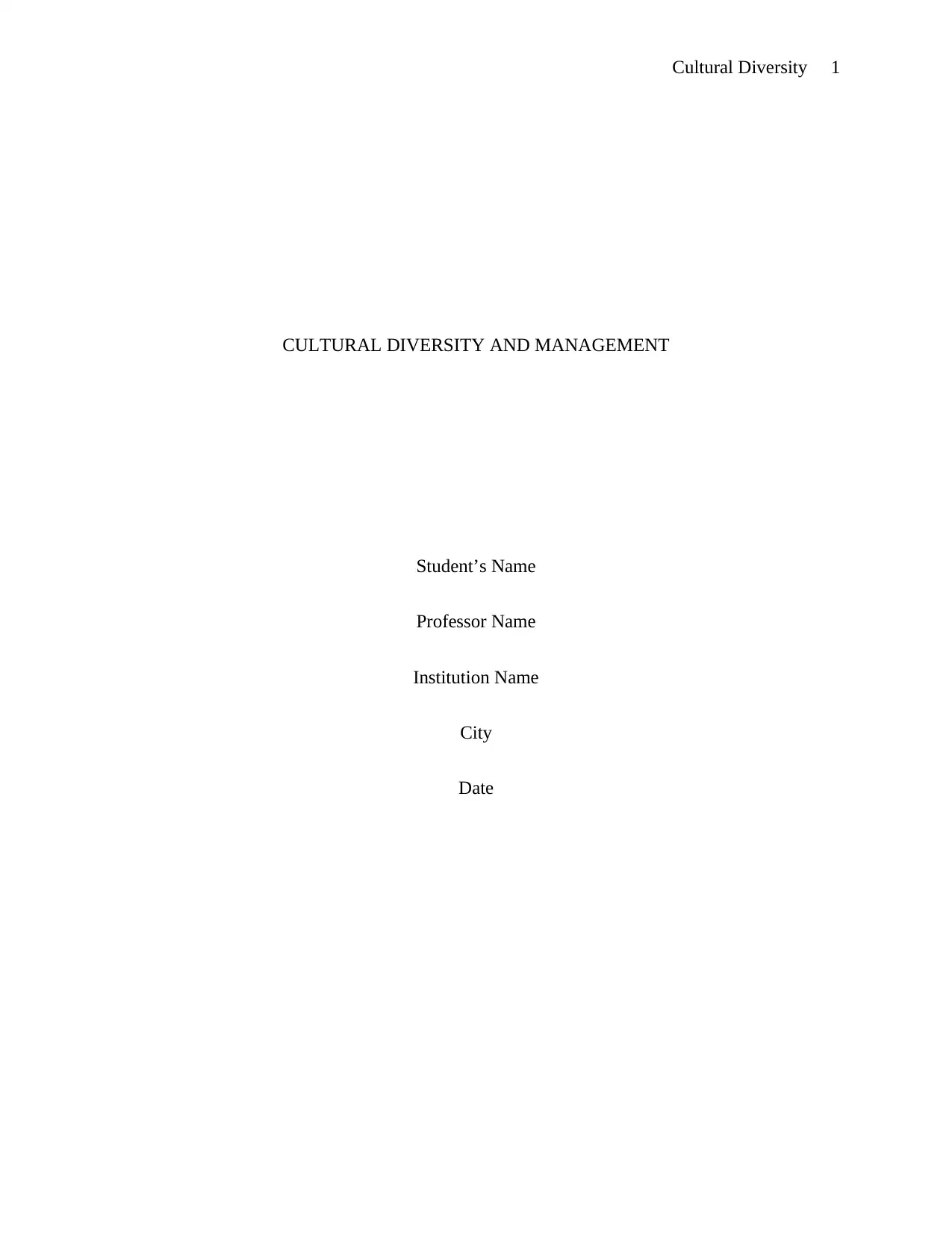
Cultural Diversity 1
CULTURAL DIVERSITY AND MANAGEMENT
Student’s Name
Professor Name
Institution Name
City
Date
CULTURAL DIVERSITY AND MANAGEMENT
Student’s Name
Professor Name
Institution Name
City
Date
Paraphrase This Document
Need a fresh take? Get an instant paraphrase of this document with our AI Paraphraser
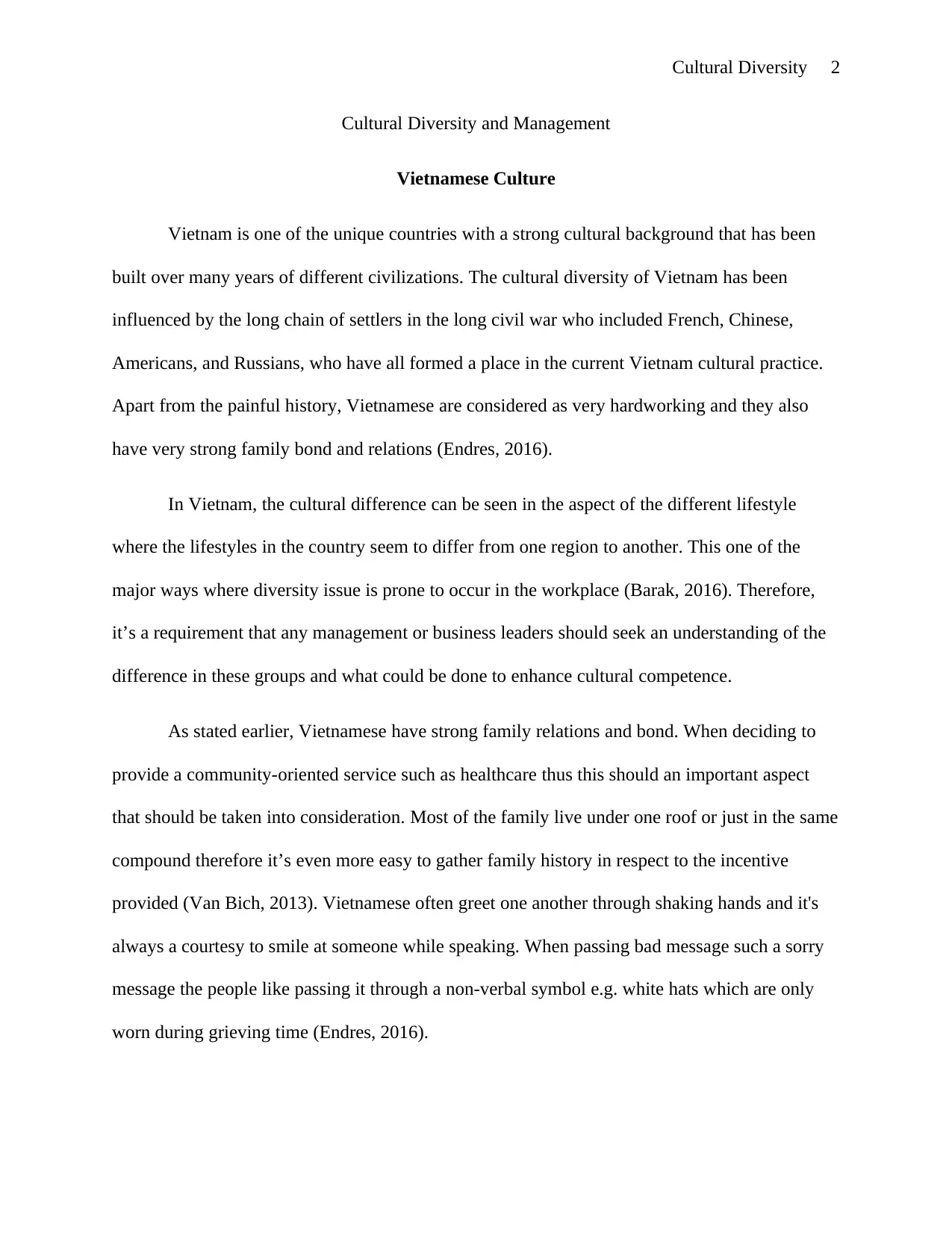
Cultural Diversity 2
Cultural Diversity and Management
Vietnamese Culture
Vietnam is one of the unique countries with a strong cultural background that has been
built over many years of different civilizations. The cultural diversity of Vietnam has been
influenced by the long chain of settlers in the long civil war who included French, Chinese,
Americans, and Russians, who have all formed a place in the current Vietnam cultural practice.
Apart from the painful history, Vietnamese are considered as very hardworking and they also
have very strong family bond and relations (Endres, 2016).
In Vietnam, the cultural difference can be seen in the aspect of the different lifestyle
where the lifestyles in the country seem to differ from one region to another. This one of the
major ways where diversity issue is prone to occur in the workplace (Barak, 2016). Therefore,
it’s a requirement that any management or business leaders should seek an understanding of the
difference in these groups and what could be done to enhance cultural competence.
As stated earlier, Vietnamese have strong family relations and bond. When deciding to
provide a community-oriented service such as healthcare thus this should an important aspect
that should be taken into consideration. Most of the family live under one roof or just in the same
compound therefore it’s even more easy to gather family history in respect to the incentive
provided (Van Bich, 2013). Vietnamese often greet one another through shaking hands and it's
always a courtesy to smile at someone while speaking. When passing bad message such a sorry
message the people like passing it through a non-verbal symbol e.g. white hats which are only
worn during grieving time (Endres, 2016).
Cultural Diversity and Management
Vietnamese Culture
Vietnam is one of the unique countries with a strong cultural background that has been
built over many years of different civilizations. The cultural diversity of Vietnam has been
influenced by the long chain of settlers in the long civil war who included French, Chinese,
Americans, and Russians, who have all formed a place in the current Vietnam cultural practice.
Apart from the painful history, Vietnamese are considered as very hardworking and they also
have very strong family bond and relations (Endres, 2016).
In Vietnam, the cultural difference can be seen in the aspect of the different lifestyle
where the lifestyles in the country seem to differ from one region to another. This one of the
major ways where diversity issue is prone to occur in the workplace (Barak, 2016). Therefore,
it’s a requirement that any management or business leaders should seek an understanding of the
difference in these groups and what could be done to enhance cultural competence.
As stated earlier, Vietnamese have strong family relations and bond. When deciding to
provide a community-oriented service such as healthcare thus this should an important aspect
that should be taken into consideration. Most of the family live under one roof or just in the same
compound therefore it’s even more easy to gather family history in respect to the incentive
provided (Van Bich, 2013). Vietnamese often greet one another through shaking hands and it's
always a courtesy to smile at someone while speaking. When passing bad message such a sorry
message the people like passing it through a non-verbal symbol e.g. white hats which are only
worn during grieving time (Endres, 2016).
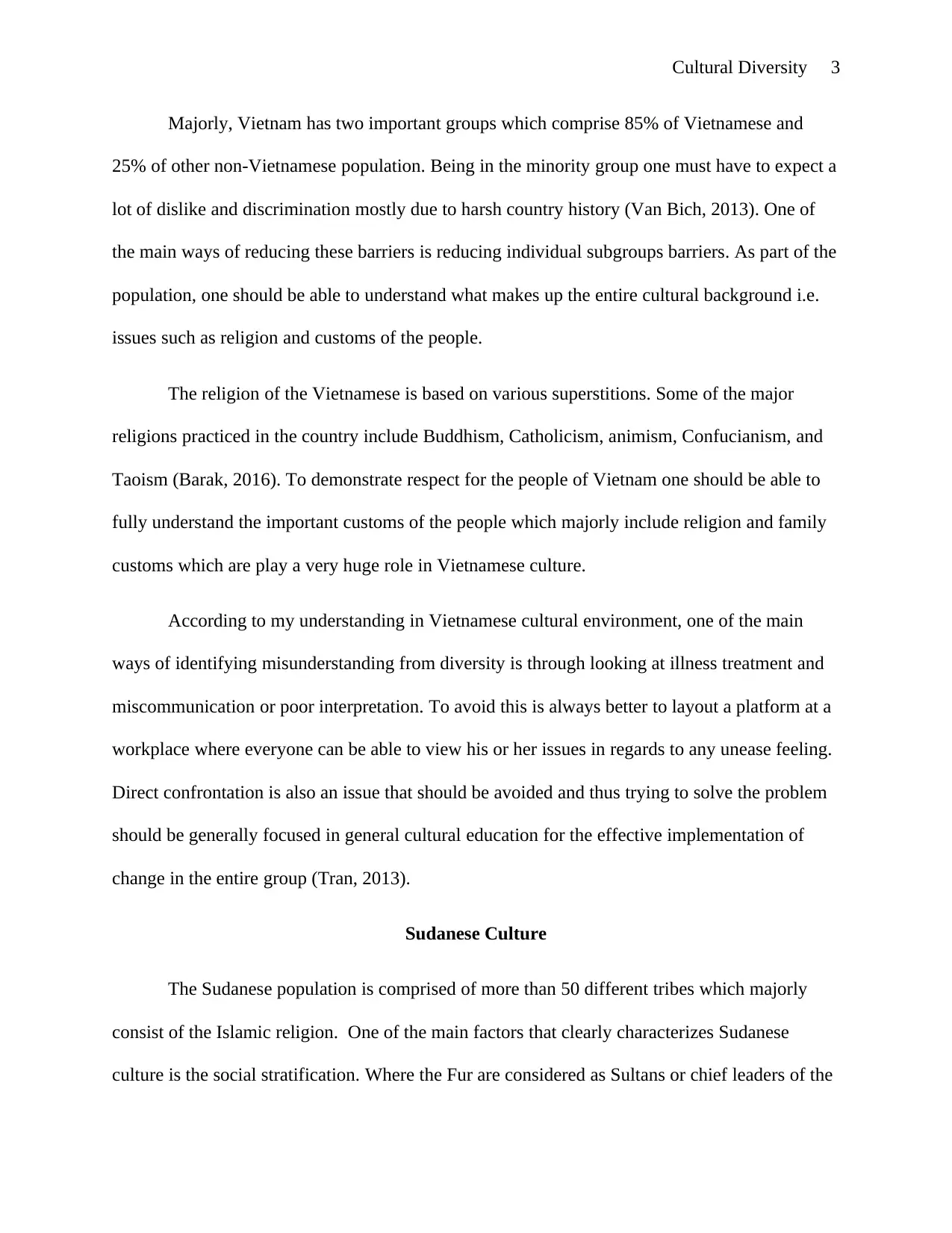
Cultural Diversity 3
Majorly, Vietnam has two important groups which comprise 85% of Vietnamese and
25% of other non-Vietnamese population. Being in the minority group one must have to expect a
lot of dislike and discrimination mostly due to harsh country history (Van Bich, 2013). One of
the main ways of reducing these barriers is reducing individual subgroups barriers. As part of the
population, one should be able to understand what makes up the entire cultural background i.e.
issues such as religion and customs of the people.
The religion of the Vietnamese is based on various superstitions. Some of the major
religions practiced in the country include Buddhism, Catholicism, animism, Confucianism, and
Taoism (Barak, 2016). To demonstrate respect for the people of Vietnam one should be able to
fully understand the important customs of the people which majorly include religion and family
customs which are play a very huge role in Vietnamese culture.
According to my understanding in Vietnamese cultural environment, one of the main
ways of identifying misunderstanding from diversity is through looking at illness treatment and
miscommunication or poor interpretation. To avoid this is always better to layout a platform at a
workplace where everyone can be able to view his or her issues in regards to any unease feeling.
Direct confrontation is also an issue that should be avoided and thus trying to solve the problem
should be generally focused in general cultural education for the effective implementation of
change in the entire group (Tran, 2013).
Sudanese Culture
The Sudanese population is comprised of more than 50 different tribes which majorly
consist of the Islamic religion. One of the main factors that clearly characterizes Sudanese
culture is the social stratification. Where the Fur are considered as Sultans or chief leaders of the
Majorly, Vietnam has two important groups which comprise 85% of Vietnamese and
25% of other non-Vietnamese population. Being in the minority group one must have to expect a
lot of dislike and discrimination mostly due to harsh country history (Van Bich, 2013). One of
the main ways of reducing these barriers is reducing individual subgroups barriers. As part of the
population, one should be able to understand what makes up the entire cultural background i.e.
issues such as religion and customs of the people.
The religion of the Vietnamese is based on various superstitions. Some of the major
religions practiced in the country include Buddhism, Catholicism, animism, Confucianism, and
Taoism (Barak, 2016). To demonstrate respect for the people of Vietnam one should be able to
fully understand the important customs of the people which majorly include religion and family
customs which are play a very huge role in Vietnamese culture.
According to my understanding in Vietnamese cultural environment, one of the main
ways of identifying misunderstanding from diversity is through looking at illness treatment and
miscommunication or poor interpretation. To avoid this is always better to layout a platform at a
workplace where everyone can be able to view his or her issues in regards to any unease feeling.
Direct confrontation is also an issue that should be avoided and thus trying to solve the problem
should be generally focused in general cultural education for the effective implementation of
change in the entire group (Tran, 2013).
Sudanese Culture
The Sudanese population is comprised of more than 50 different tribes which majorly
consist of the Islamic religion. One of the main factors that clearly characterizes Sudanese
culture is the social stratification. Where the Fur are considered as Sultans or chief leaders of the
⊘ This is a preview!⊘
Do you want full access?
Subscribe today to unlock all pages.

Trusted by 1+ million students worldwide
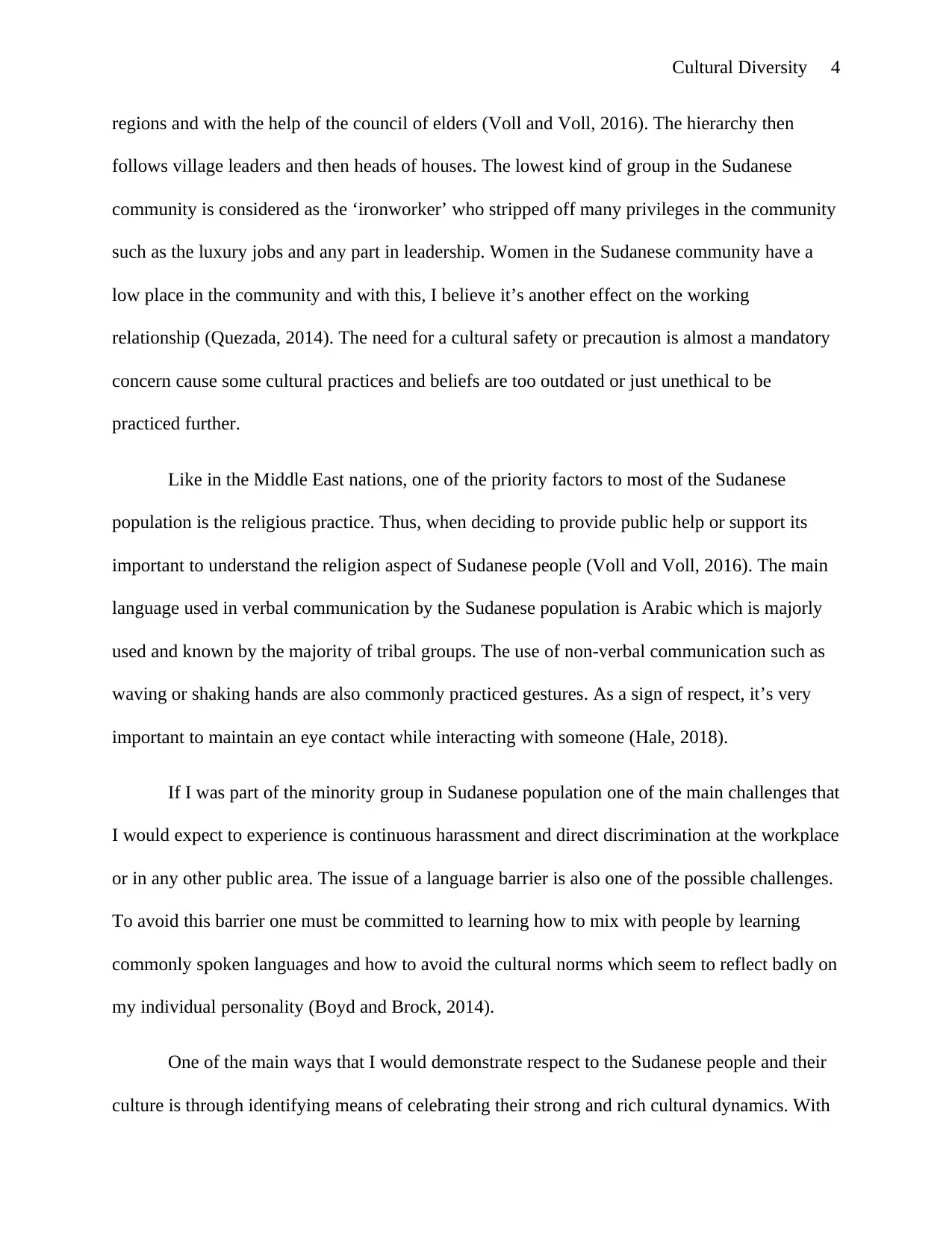
Cultural Diversity 4
regions and with the help of the council of elders (Voll and Voll, 2016). The hierarchy then
follows village leaders and then heads of houses. The lowest kind of group in the Sudanese
community is considered as the ‘ironworker’ who stripped off many privileges in the community
such as the luxury jobs and any part in leadership. Women in the Sudanese community have a
low place in the community and with this, I believe it’s another effect on the working
relationship (Quezada, 2014). The need for a cultural safety or precaution is almost a mandatory
concern cause some cultural practices and beliefs are too outdated or just unethical to be
practiced further.
Like in the Middle East nations, one of the priority factors to most of the Sudanese
population is the religious practice. Thus, when deciding to provide public help or support its
important to understand the religion aspect of Sudanese people (Voll and Voll, 2016). The main
language used in verbal communication by the Sudanese population is Arabic which is majorly
used and known by the majority of tribal groups. The use of non-verbal communication such as
waving or shaking hands are also commonly practiced gestures. As a sign of respect, it’s very
important to maintain an eye contact while interacting with someone (Hale, 2018).
If I was part of the minority group in Sudanese population one of the main challenges that
I would expect to experience is continuous harassment and direct discrimination at the workplace
or in any other public area. The issue of a language barrier is also one of the possible challenges.
To avoid this barrier one must be committed to learning how to mix with people by learning
commonly spoken languages and how to avoid the cultural norms which seem to reflect badly on
my individual personality (Boyd and Brock, 2014).
One of the main ways that I would demonstrate respect to the Sudanese people and their
culture is through identifying means of celebrating their strong and rich cultural dynamics. With
regions and with the help of the council of elders (Voll and Voll, 2016). The hierarchy then
follows village leaders and then heads of houses. The lowest kind of group in the Sudanese
community is considered as the ‘ironworker’ who stripped off many privileges in the community
such as the luxury jobs and any part in leadership. Women in the Sudanese community have a
low place in the community and with this, I believe it’s another effect on the working
relationship (Quezada, 2014). The need for a cultural safety or precaution is almost a mandatory
concern cause some cultural practices and beliefs are too outdated or just unethical to be
practiced further.
Like in the Middle East nations, one of the priority factors to most of the Sudanese
population is the religious practice. Thus, when deciding to provide public help or support its
important to understand the religion aspect of Sudanese people (Voll and Voll, 2016). The main
language used in verbal communication by the Sudanese population is Arabic which is majorly
used and known by the majority of tribal groups. The use of non-verbal communication such as
waving or shaking hands are also commonly practiced gestures. As a sign of respect, it’s very
important to maintain an eye contact while interacting with someone (Hale, 2018).
If I was part of the minority group in Sudanese population one of the main challenges that
I would expect to experience is continuous harassment and direct discrimination at the workplace
or in any other public area. The issue of a language barrier is also one of the possible challenges.
To avoid this barrier one must be committed to learning how to mix with people by learning
commonly spoken languages and how to avoid the cultural norms which seem to reflect badly on
my individual personality (Boyd and Brock, 2014).
One of the main ways that I would demonstrate respect to the Sudanese people and their
culture is through identifying means of celebrating their strong and rich cultural dynamics. With
Paraphrase This Document
Need a fresh take? Get an instant paraphrase of this document with our AI Paraphraser
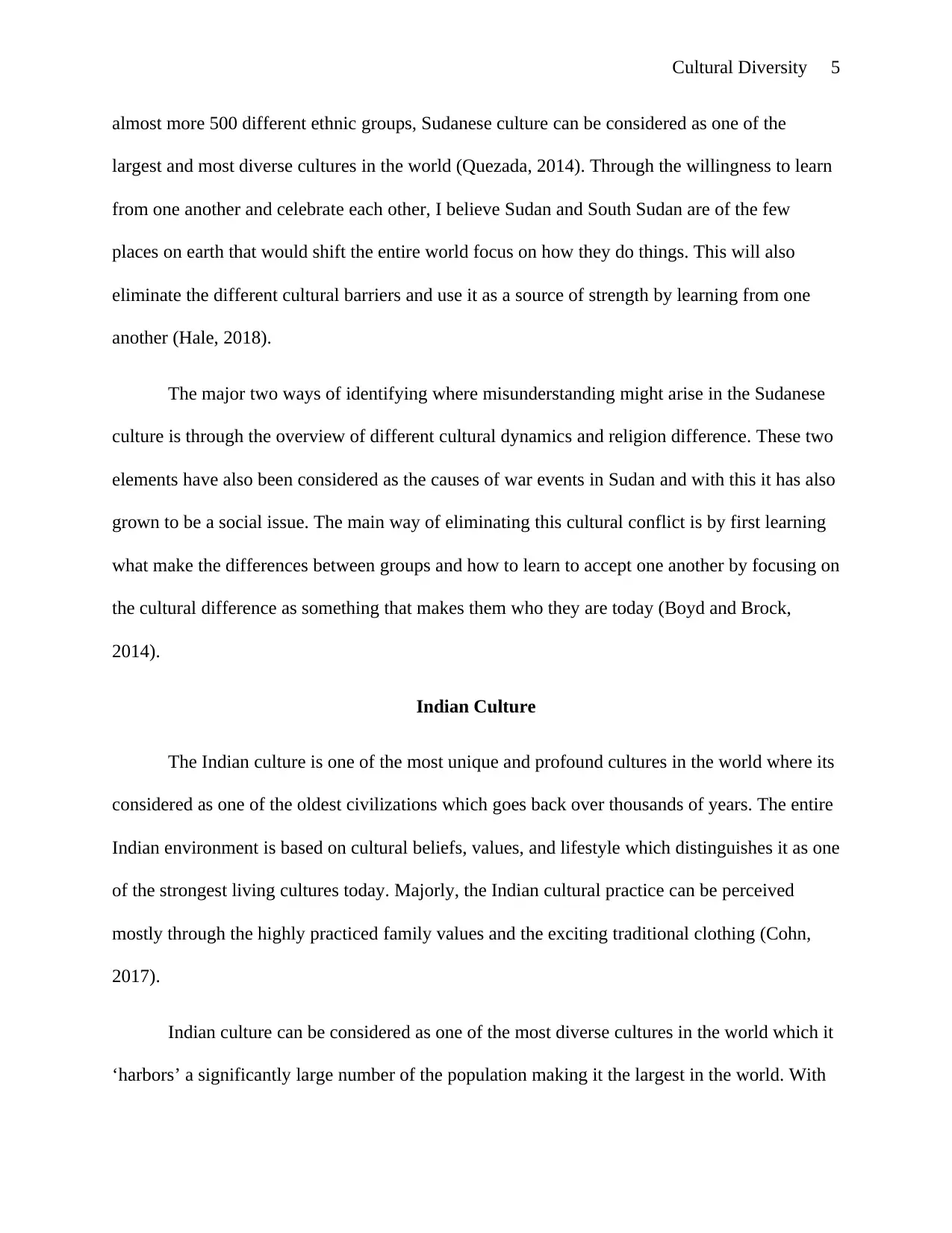
Cultural Diversity 5
almost more 500 different ethnic groups, Sudanese culture can be considered as one of the
largest and most diverse cultures in the world (Quezada, 2014). Through the willingness to learn
from one another and celebrate each other, I believe Sudan and South Sudan are of the few
places on earth that would shift the entire world focus on how they do things. This will also
eliminate the different cultural barriers and use it as a source of strength by learning from one
another (Hale, 2018).
The major two ways of identifying where misunderstanding might arise in the Sudanese
culture is through the overview of different cultural dynamics and religion difference. These two
elements have also been considered as the causes of war events in Sudan and with this it has also
grown to be a social issue. The main way of eliminating this cultural conflict is by first learning
what make the differences between groups and how to learn to accept one another by focusing on
the cultural difference as something that makes them who they are today (Boyd and Brock,
2014).
Indian Culture
The Indian culture is one of the most unique and profound cultures in the world where its
considered as one of the oldest civilizations which goes back over thousands of years. The entire
Indian environment is based on cultural beliefs, values, and lifestyle which distinguishes it as one
of the strongest living cultures today. Majorly, the Indian cultural practice can be perceived
mostly through the highly practiced family values and the exciting traditional clothing (Cohn,
2017).
Indian culture can be considered as one of the most diverse cultures in the world which it
‘harbors’ a significantly large number of the population making it the largest in the world. With
almost more 500 different ethnic groups, Sudanese culture can be considered as one of the
largest and most diverse cultures in the world (Quezada, 2014). Through the willingness to learn
from one another and celebrate each other, I believe Sudan and South Sudan are of the few
places on earth that would shift the entire world focus on how they do things. This will also
eliminate the different cultural barriers and use it as a source of strength by learning from one
another (Hale, 2018).
The major two ways of identifying where misunderstanding might arise in the Sudanese
culture is through the overview of different cultural dynamics and religion difference. These two
elements have also been considered as the causes of war events in Sudan and with this it has also
grown to be a social issue. The main way of eliminating this cultural conflict is by first learning
what make the differences between groups and how to learn to accept one another by focusing on
the cultural difference as something that makes them who they are today (Boyd and Brock,
2014).
Indian Culture
The Indian culture is one of the most unique and profound cultures in the world where its
considered as one of the oldest civilizations which goes back over thousands of years. The entire
Indian environment is based on cultural beliefs, values, and lifestyle which distinguishes it as one
of the strongest living cultures today. Majorly, the Indian cultural practice can be perceived
mostly through the highly practiced family values and the exciting traditional clothing (Cohn,
2017).
Indian culture can be considered as one of the most diverse cultures in the world which it
‘harbors’ a significantly large number of the population making it the largest in the world. With
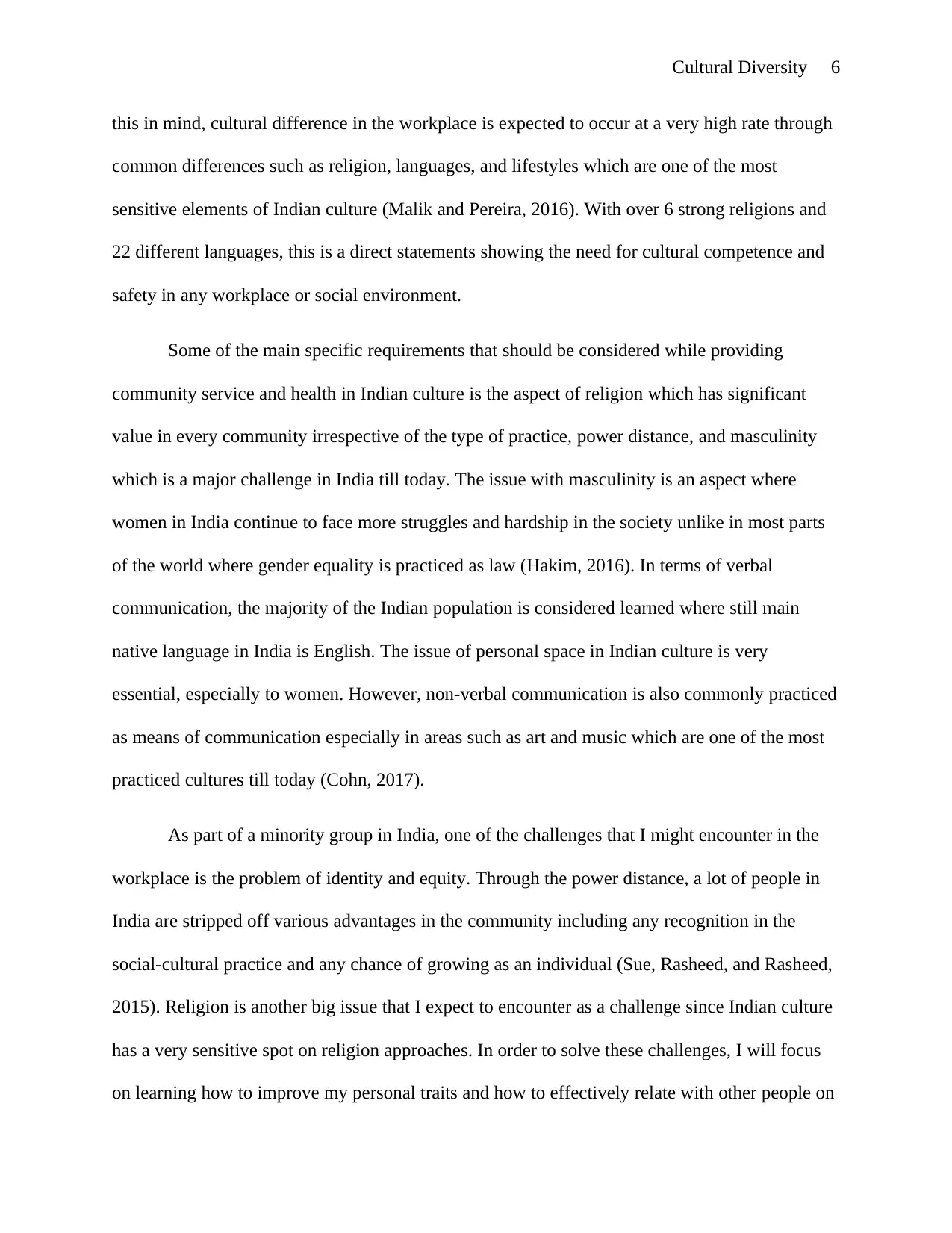
Cultural Diversity 6
this in mind, cultural difference in the workplace is expected to occur at a very high rate through
common differences such as religion, languages, and lifestyles which are one of the most
sensitive elements of Indian culture (Malik and Pereira, 2016). With over 6 strong religions and
22 different languages, this is a direct statements showing the need for cultural competence and
safety in any workplace or social environment.
Some of the main specific requirements that should be considered while providing
community service and health in Indian culture is the aspect of religion which has significant
value in every community irrespective of the type of practice, power distance, and masculinity
which is a major challenge in India till today. The issue with masculinity is an aspect where
women in India continue to face more struggles and hardship in the society unlike in most parts
of the world where gender equality is practiced as law (Hakim, 2016). In terms of verbal
communication, the majority of the Indian population is considered learned where still main
native language in India is English. The issue of personal space in Indian culture is very
essential, especially to women. However, non-verbal communication is also commonly practiced
as means of communication especially in areas such as art and music which are one of the most
practiced cultures till today (Cohn, 2017).
As part of a minority group in India, one of the challenges that I might encounter in the
workplace is the problem of identity and equity. Through the power distance, a lot of people in
India are stripped off various advantages in the community including any recognition in the
social-cultural practice and any chance of growing as an individual (Sue, Rasheed, and Rasheed,
2015). Religion is another big issue that I expect to encounter as a challenge since Indian culture
has a very sensitive spot on religion approaches. In order to solve these challenges, I will focus
on learning how to improve my personal traits and how to effectively relate with other people on
this in mind, cultural difference in the workplace is expected to occur at a very high rate through
common differences such as religion, languages, and lifestyles which are one of the most
sensitive elements of Indian culture (Malik and Pereira, 2016). With over 6 strong religions and
22 different languages, this is a direct statements showing the need for cultural competence and
safety in any workplace or social environment.
Some of the main specific requirements that should be considered while providing
community service and health in Indian culture is the aspect of religion which has significant
value in every community irrespective of the type of practice, power distance, and masculinity
which is a major challenge in India till today. The issue with masculinity is an aspect where
women in India continue to face more struggles and hardship in the society unlike in most parts
of the world where gender equality is practiced as law (Hakim, 2016). In terms of verbal
communication, the majority of the Indian population is considered learned where still main
native language in India is English. The issue of personal space in Indian culture is very
essential, especially to women. However, non-verbal communication is also commonly practiced
as means of communication especially in areas such as art and music which are one of the most
practiced cultures till today (Cohn, 2017).
As part of a minority group in India, one of the challenges that I might encounter in the
workplace is the problem of identity and equity. Through the power distance, a lot of people in
India are stripped off various advantages in the community including any recognition in the
social-cultural practice and any chance of growing as an individual (Sue, Rasheed, and Rasheed,
2015). Religion is another big issue that I expect to encounter as a challenge since Indian culture
has a very sensitive spot on religion approaches. In order to solve these challenges, I will focus
on learning how to improve my personal traits and how to effectively relate with other people on
⊘ This is a preview!⊘
Do you want full access?
Subscribe today to unlock all pages.

Trusted by 1+ million students worldwide
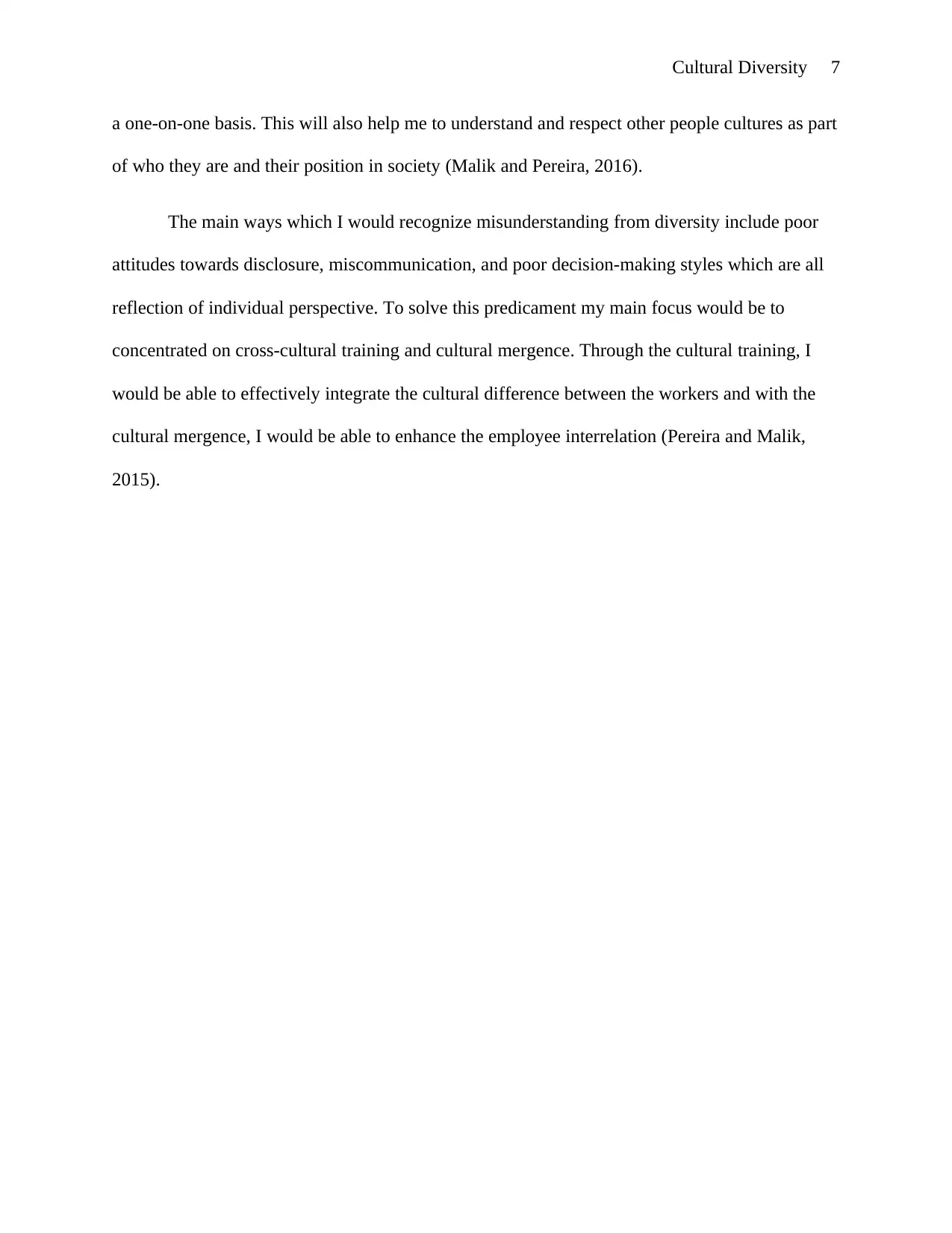
Cultural Diversity 7
a one-on-one basis. This will also help me to understand and respect other people cultures as part
of who they are and their position in society (Malik and Pereira, 2016).
The main ways which I would recognize misunderstanding from diversity include poor
attitudes towards disclosure, miscommunication, and poor decision-making styles which are all
reflection of individual perspective. To solve this predicament my main focus would be to
concentrated on cross-cultural training and cultural mergence. Through the cultural training, I
would be able to effectively integrate the cultural difference between the workers and with the
cultural mergence, I would be able to enhance the employee interrelation (Pereira and Malik,
2015).
a one-on-one basis. This will also help me to understand and respect other people cultures as part
of who they are and their position in society (Malik and Pereira, 2016).
The main ways which I would recognize misunderstanding from diversity include poor
attitudes towards disclosure, miscommunication, and poor decision-making styles which are all
reflection of individual perspective. To solve this predicament my main focus would be to
concentrated on cross-cultural training and cultural mergence. Through the cultural training, I
would be able to effectively integrate the cultural difference between the workers and with the
cultural mergence, I would be able to enhance the employee interrelation (Pereira and Malik,
2015).
Paraphrase This Document
Need a fresh take? Get an instant paraphrase of this document with our AI Paraphraser
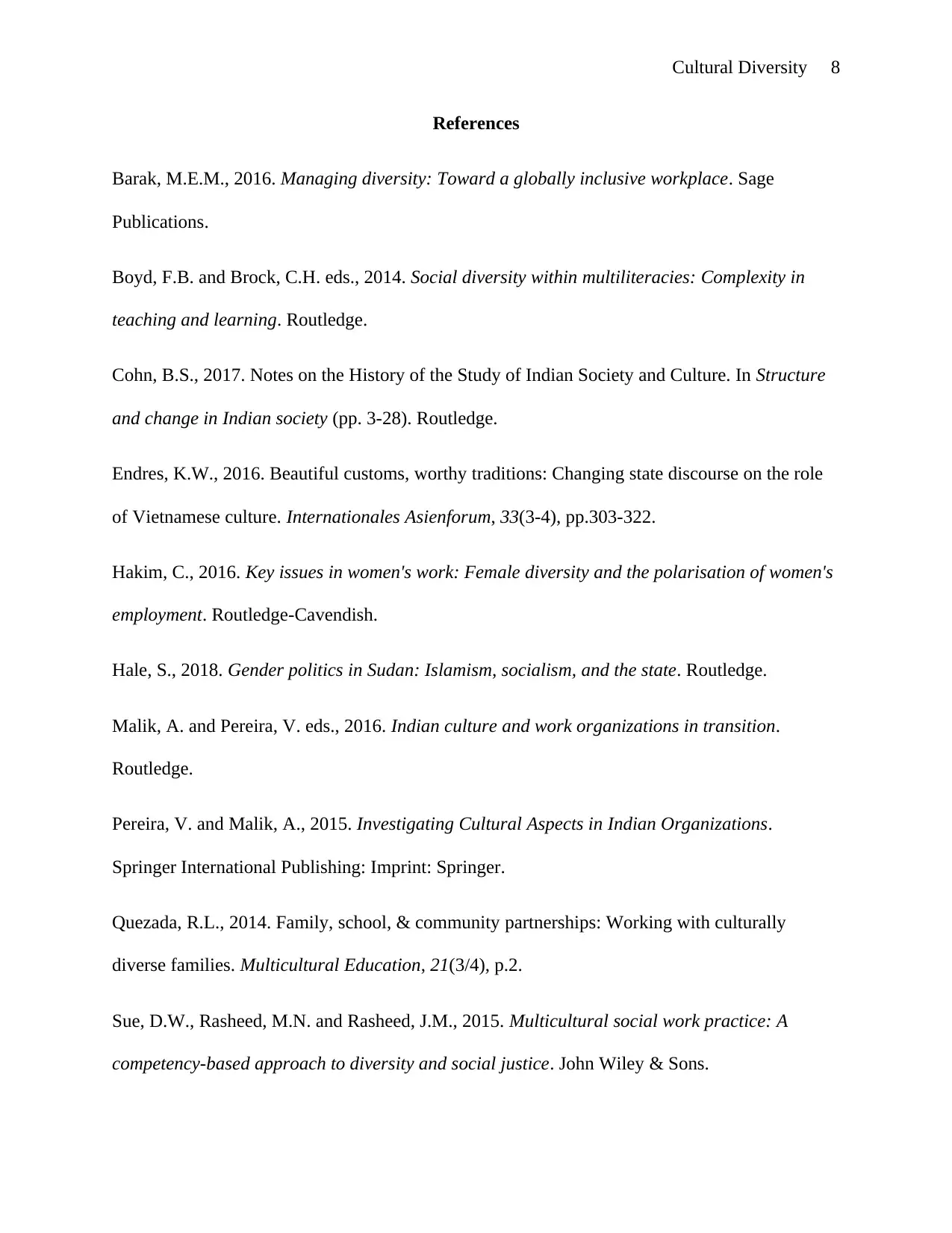
Cultural Diversity 8
References
Barak, M.E.M., 2016. Managing diversity: Toward a globally inclusive workplace. Sage
Publications.
Boyd, F.B. and Brock, C.H. eds., 2014. Social diversity within multiliteracies: Complexity in
teaching and learning. Routledge.
Cohn, B.S., 2017. Notes on the History of the Study of Indian Society and Culture. In Structure
and change in Indian society (pp. 3-28). Routledge.
Endres, K.W., 2016. Beautiful customs, worthy traditions: Changing state discourse on the role
of Vietnamese culture. Internationales Asienforum, 33(3-4), pp.303-322.
Hakim, C., 2016. Key issues in women's work: Female diversity and the polarisation of women's
employment. Routledge-Cavendish.
Hale, S., 2018. Gender politics in Sudan: Islamism, socialism, and the state. Routledge.
Malik, A. and Pereira, V. eds., 2016. Indian culture and work organizations in transition.
Routledge.
Pereira, V. and Malik, A., 2015. Investigating Cultural Aspects in Indian Organizations.
Springer International Publishing: Imprint: Springer.
Quezada, R.L., 2014. Family, school, & community partnerships: Working with culturally
diverse families. Multicultural Education, 21(3/4), p.2.
Sue, D.W., Rasheed, M.N. and Rasheed, J.M., 2015. Multicultural social work practice: A
competency-based approach to diversity and social justice. John Wiley & Sons.
References
Barak, M.E.M., 2016. Managing diversity: Toward a globally inclusive workplace. Sage
Publications.
Boyd, F.B. and Brock, C.H. eds., 2014. Social diversity within multiliteracies: Complexity in
teaching and learning. Routledge.
Cohn, B.S., 2017. Notes on the History of the Study of Indian Society and Culture. In Structure
and change in Indian society (pp. 3-28). Routledge.
Endres, K.W., 2016. Beautiful customs, worthy traditions: Changing state discourse on the role
of Vietnamese culture. Internationales Asienforum, 33(3-4), pp.303-322.
Hakim, C., 2016. Key issues in women's work: Female diversity and the polarisation of women's
employment. Routledge-Cavendish.
Hale, S., 2018. Gender politics in Sudan: Islamism, socialism, and the state. Routledge.
Malik, A. and Pereira, V. eds., 2016. Indian culture and work organizations in transition.
Routledge.
Pereira, V. and Malik, A., 2015. Investigating Cultural Aspects in Indian Organizations.
Springer International Publishing: Imprint: Springer.
Quezada, R.L., 2014. Family, school, & community partnerships: Working with culturally
diverse families. Multicultural Education, 21(3/4), p.2.
Sue, D.W., Rasheed, M.N. and Rasheed, J.M., 2015. Multicultural social work practice: A
competency-based approach to diversity and social justice. John Wiley & Sons.
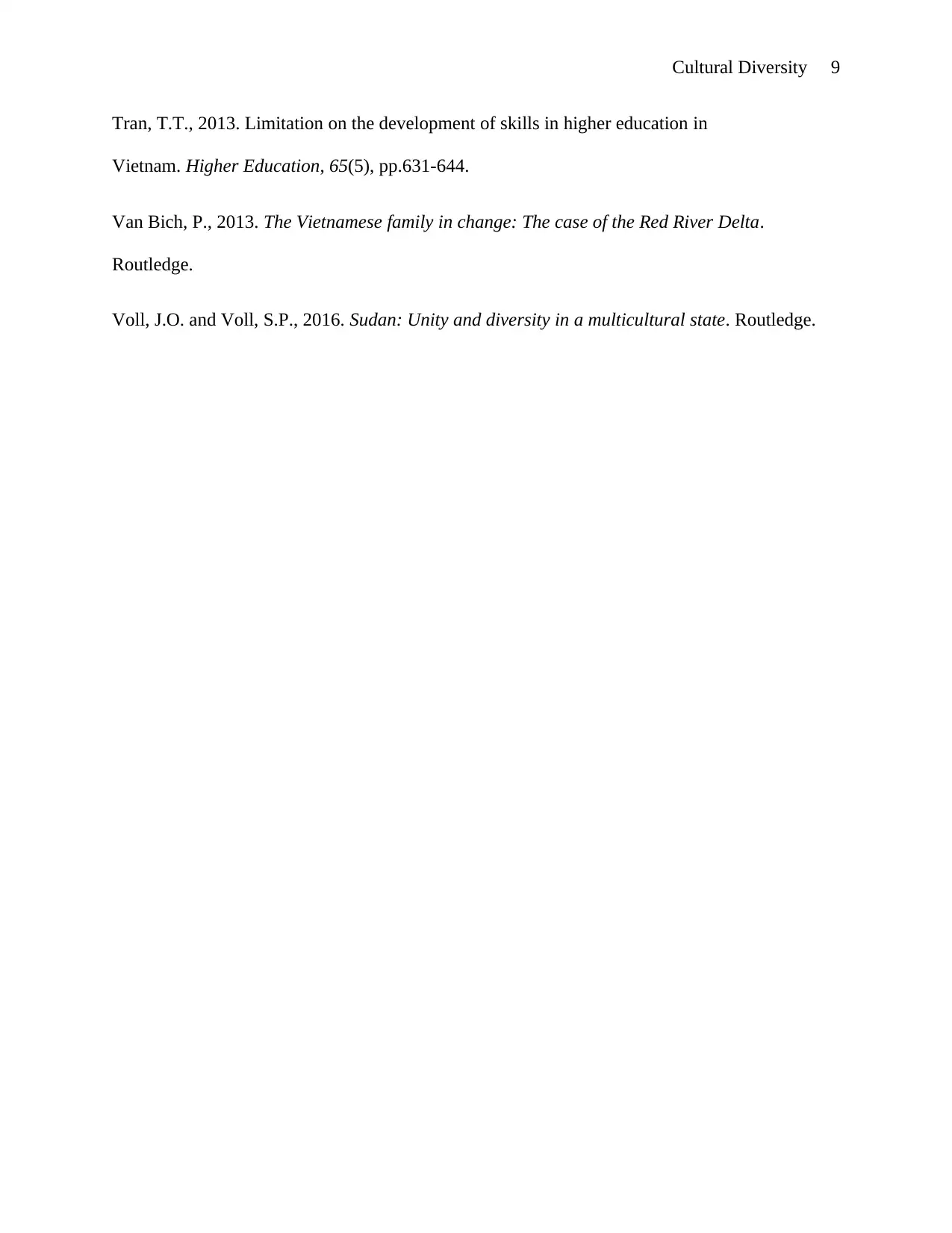
Cultural Diversity 9
Tran, T.T., 2013. Limitation on the development of skills in higher education in
Vietnam. Higher Education, 65(5), pp.631-644.
Van Bich, P., 2013. The Vietnamese family in change: The case of the Red River Delta.
Routledge.
Voll, J.O. and Voll, S.P., 2016. Sudan: Unity and diversity in a multicultural state. Routledge.
Tran, T.T., 2013. Limitation on the development of skills in higher education in
Vietnam. Higher Education, 65(5), pp.631-644.
Van Bich, P., 2013. The Vietnamese family in change: The case of the Red River Delta.
Routledge.
Voll, J.O. and Voll, S.P., 2016. Sudan: Unity and diversity in a multicultural state. Routledge.
⊘ This is a preview!⊘
Do you want full access?
Subscribe today to unlock all pages.

Trusted by 1+ million students worldwide
1 out of 9
Your All-in-One AI-Powered Toolkit for Academic Success.
+13062052269
info@desklib.com
Available 24*7 on WhatsApp / Email
![[object Object]](/_next/static/media/star-bottom.7253800d.svg)
Unlock your academic potential
Copyright © 2020–2025 A2Z Services. All Rights Reserved. Developed and managed by ZUCOL.

